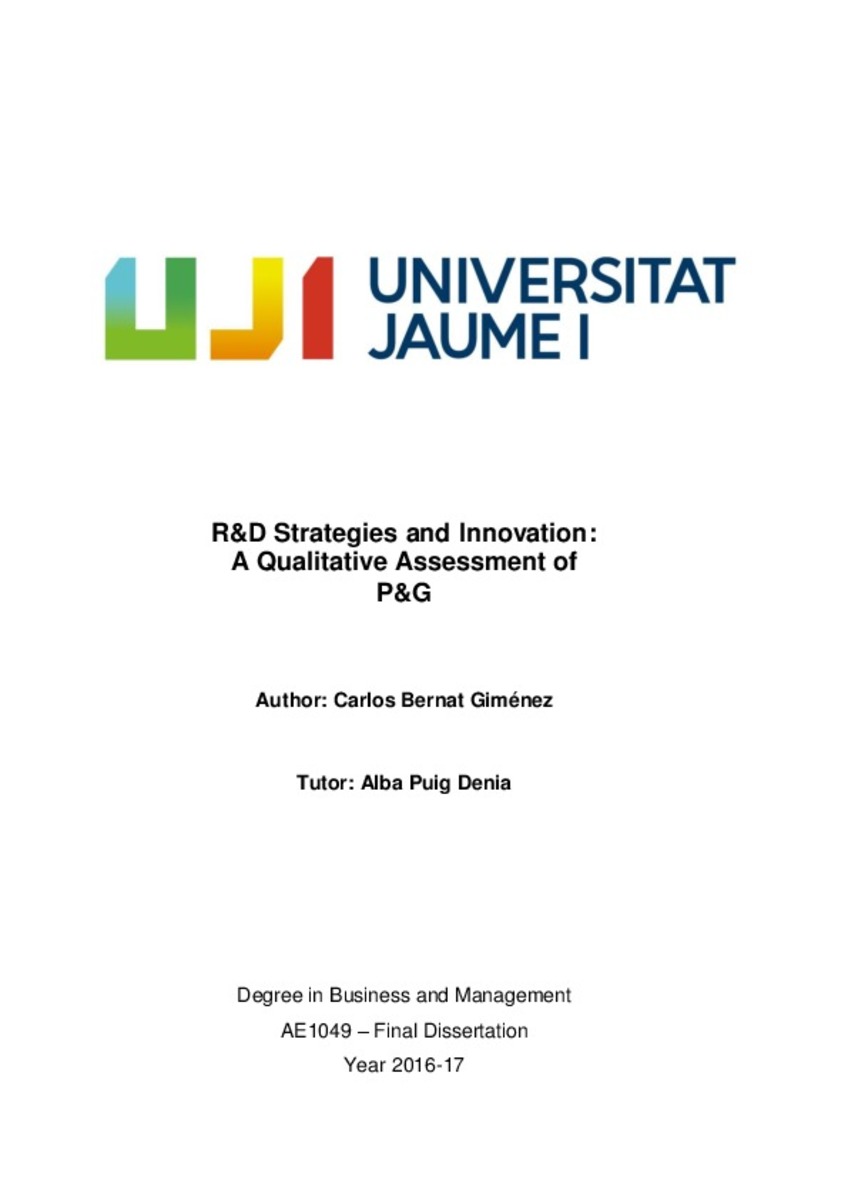Mostrar el registro sencillo del ítem
R&D strategies and innovation. a qualitative assessment of P&G
| dc.contributor.author | Bernat Giménez, Carlos | |
| dc.contributor.other | Puig Denia, Alba | |
| dc.contributor.other | Universitat Jaume I. Departament d'Administració d'Empreses i Màrqueting Fecha de publicación | |
| dc.date.accessioned | 2017-11-27T10:05:34Z | |
| dc.date.available | 2017-11-27T10:05:34Z | |
| dc.date.issued | 2017-07-11 | |
| dc.identifier.uri | http://hdl.handle.net/10234/170413 | |
| dc.description | Treball Final de Grau en Administració d'Empreses. Codi: AE1049. Curs acadèmic: 2016/2017 | |
| dc.description.abstract | In a globalised world with ever-changing trends and customers’ needs, organisations must adapt to the new environment and requirements exposed by the market. This situation binds them to keep looking for new ways to meet those needs since the traditional products and methods to do so no longer give value to consumers, who are ready to pay an extra price for a good or service that provides a different experience from the rest of goods in the market. This encourages firms to push their frontiers further, trying to find real and valuable solutions by researching and developing new technology that can define the satisfaction of the new needs that customers have. However, there are products that, for its own nature, don’t have room for much improvement and change, meaning that the product remains stagnant in time, unchanged. Needs keep evolving but these products can’t match them that easily because they have reached maturity and can’t be substituted by another technology, at least, so far. This paper understands and acknowledges the existence of technologies that are traditionally stagnant and mature and tries to give qualitative evidence, based on a real case, on how companies can develop these type of technologies, which have no room for improvement or change, while serving as a descriptive guide about the strategies regarding innovation that can be followed in order to make the development of such technologies and launch them to the market. As a result, the first part of the paper deals with the definition and difference between technology and innovation, followed by the theories that explain the management of innovation strategies and the meaningful repercussions of their implementation. Meanwhile, the second part refers to a real business case, involving the multinational company P&G and the strategies that it uses to complete the innovative projects it embarks on successfully. In other words, this part covers the empirical evidence that sustains the previous theories and gives light on how mature products can still be improved through effort and persistency, by looking for examples on databases, legal court registries and business articles and reviews about its corporate arena and the firm itself. | ca_CA |
| dc.format.extent | 51 p. | ca_CA |
| dc.format.mimetype | application/pdf | ca_CA |
| dc.language.iso | eng | ca_CA |
| dc.publisher | Universitat Jaume I | ca_CA |
| dc.rights | Atribución-NoComercial-CompartirIgual 4.0 Internacional | * |
| dc.rights.uri | http://creativecommons.org/licenses/by-nc-sa/4.0/ | * |
| dc.subject | Grau en Administració d'Empreses | ca_CA |
| dc.subject | Grado en Administración de Empresas | ca_CA |
| dc.subject | Bachelor's Degree in Business Administration | ca_CA |
| dc.subject | R&D | ca_CA |
| dc.subject | multinational company | ca_CA |
| dc.subject | qualitative assessment | ca_CA |
| dc.subject | innovation strategies | ca_CA |
| dc.subject | technology | ca_CA |
| dc.title | R&D strategies and innovation. a qualitative assessment of P&G | ca_CA |
| dc.type | info:eu-repo/semantics/bachelorThesis | ca_CA |
| dc.educationLevel | Estudios de Grado | ca_CA |
| dc.rights.accessRights | info:eu-repo/semantics/openAccess | ca_CA |
Ficheros en el ítem
Este ítem aparece en la(s) siguiente(s) colección(ones)
-
Grau en Administració d'Empreses [705]
AE1049








